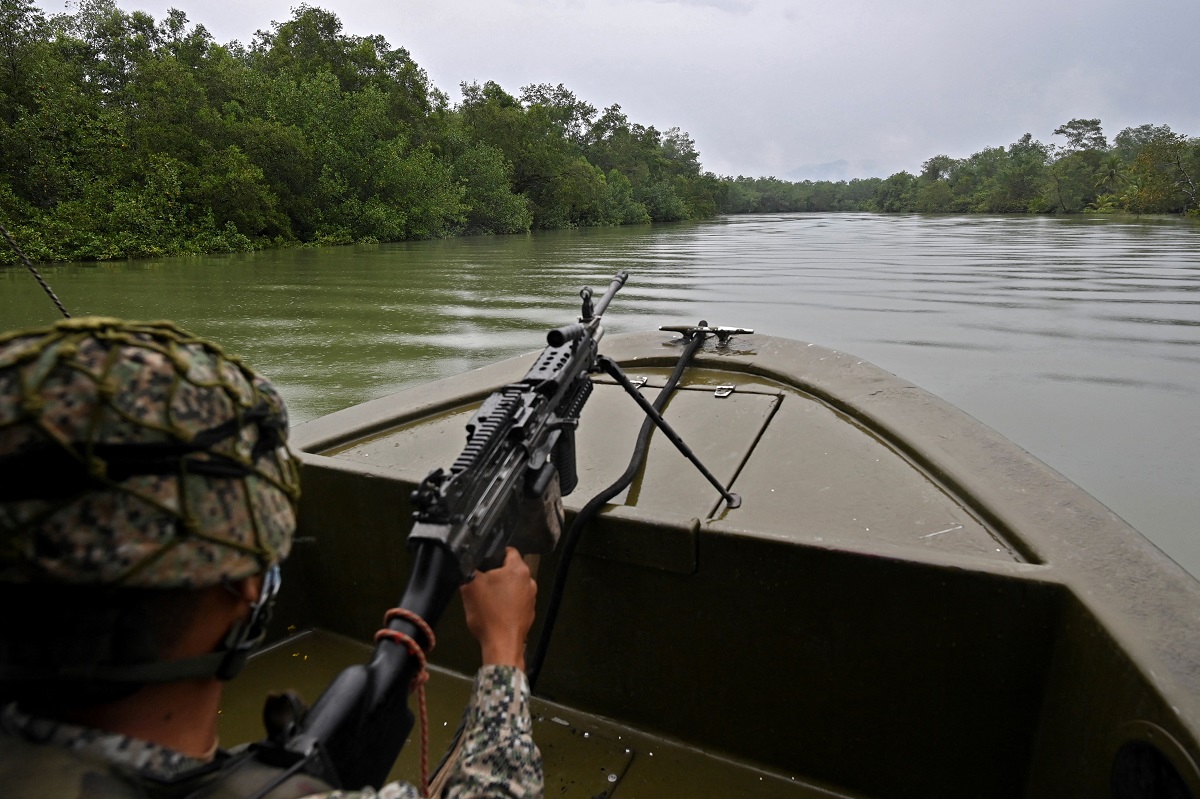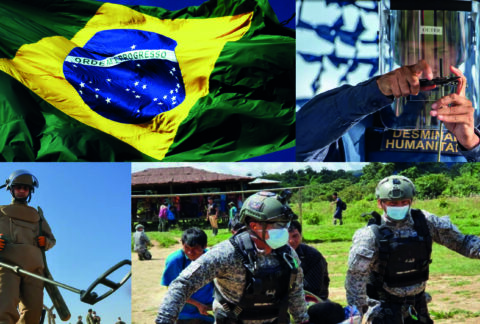Abstract
This research article is developed from the study of the educational system of the Military Forces, within the framework of the guidelines issued by the Ministry of National Defense (MDN) since 2007, through the Strategic Plan of the Educational System (PESE), established the educational policies to improve in all aspects the education and training of its Human Talent (Ministry of National Defense, 2008). The National Navy, congruent with the aspirations of the Ministry of Defense and the General Command of the Military Forces (CGFFMM), assumes naval education as one of the fundamental supports for the fulfillment of the constitutional mission, seeking the full development of the most important resource: its human capital (Armada Nacional de Colombia, 2016). In order to comply with the policies on education issues issued by the MDN and the National Navy, as well as to improve the performance of the crew members aboard the National Navy units to become a Navy of regional projection and influence, this paper seeks to raise the geopolitical and strategic educational factors to be a Navy of regional projection and influence.
Key words: Military strategy, Geopolitics, Influence, Education.
Introduction
In the political, economic and military development of any state, the strategy used for the creation, maintenance and use of its interests always stands out. But if it is a maritime power, it is the success of its maritime strategy that will mark its course (Britto, 2000). Colombia, being a nation with direct oceanic projection to the five continents, has the opportunity to structure National Maritime Interests that integrate all interests, efforts and strengths (Rengifo, 2008). These Maritime Interests are an opportunity to strengthen all national maritime development.
While it is true that the maritime awareness of a people is the only mechanism that allows a coastal state to become a maritime power, this process cannot be achieved without first defining and accepting that the sea is “the means” for the development of the present and the future. The acceptance of this premise is only possible if a large critical mass is convinced of it and recognizes that it is not just another initiative, but on the contrary, it is the only way to avoid being left behind in the face of the complex processes brought about by globalization (Till, 2007).
The Colombian State, has had significant advances towards the development of public policies in oceanic, coastal and insular spaces through the protection and conservation of the marine environment, its natural resources and biodiversity, with the support of the Colombian Ocean Commission (CCO) and the National Ocean and Coastal Spaces Policy (PNOEC) where sustainability is promoted (Comisión Nacional del Océano, 2018), additional, it is necessary to exalt the inclusion of the oceans in the NDP 2018-2022 Pact for Colombia, Pact for Equity as a strategic asset for the development of the country, which is the first time that a national development plan takes into account the oceans as a strategic asset of the Nation and as an engine for growth and equity. (National Planning Department, 2020)
The sea has been a protagonist in the development of each and every one of the great powers throughout history, Colombia as of March 31, 2020 through the National Council of Economic and Social Policy 3990 which refers to “Colombia Sustainable Bioceanic Power 2030”, defined its maritime interests and the lines of action in which it seeks to impact the main maritime sectors of the nation, among which is maritime education, in addition to being of a prospective and strategic nature, which seeks to position the oceans as a factor of sustainable development and the creation, maintenance, employment, protection and promotion of Colombia’s maritime interests in the national public agenda.
The different governments in the last 20 years have created national public policies regarding everything related to maritime interests, starting with the National Environmental Policy for the Sustainable Development of Oceanic Spaces and Coastal and Insular Zones of Colombia (PNAOCI), later with the National Ocean and Coastal Spaces Policy (PNOEC) and fortunately in 2020 the National Council of Economic and Social Policy (CONPES) created a document where strategies and actions are proposed in order to turn Colombia into a sustainable bio-oceanic power by the year 2030, which is aligned with the National Development Plan 2018-2022 and the Sustainable Development Goals promoted by the United Nations, all these public policies are aligned with a factor related to maritime education, which is necessary to strengthen it with the determination of geopolitical and strategic educational factors that allow the seas and coastal areas to be known not only in its geographical reality, its historical reality and its cultural reality, but also in the great variety of productive possibilities and development of economic activities to be really considered as an alternative for development.
The National Navy of Colombia has contemplated in its functional and strategic organization to project itself as a Navy of regional projection and influence (Armada Nacional de Colombia, 2020), with an oceanic defensive force, guarantor of the Nation’s maritime interests and with the capacity to carry out Maritime Security operations in the Exclusive Economic Zone and Naval Warfare in the established theaters of Operations, serving as support to the foreign policy of the national government, as well as contributing to the technological, scientific, social and economic development of the Nation. This vision contemplates the use of the available means, maritime and fluvial units, and these means in turn require trained personnel to maintain and operate them. To this end and in order to meet the advances and the availability of new technological means and Naval Units, some geopolitical and strategic educational factors are presented to be taken into account in order to be a Navy of regional projection and influence.
The evolution of the Military Profession up to the Training Schools of the National Navy.
According to Huntington (1995), the modern form of the military profession was initially given in Prussia, at the beginning of the 19th century, on August 6, 1808, when the decree of designation of Officers of the Prussian army was issued and at this moment the military profession was institutionalized. For García (2003), the emergence of the modern form of military career took place in 1875 in the USA when General Sherman entrusted General Emory Upton with the organization of a military force based on merit-based selection, which would be trained in specialized centers and with a system of promotions and retirements.
For its part, the military strategic thinking that will be developed in the permanent conflicts and wars that took place in the kingdoms and emerging nations of Europe and Asia during the 19th and 20th centuries will be based on the concepts of several thinkers, among them Clausewitz (1832), Prussian general, his book “On War” allows us to appreciate a global view of military conflict using new terms in which the economy of forces, war as a duel on a broader scale, civil-military relations, “War is the continuation of politics by other means” stand out. For him, every organization requires careful strategic planning in which decisions must be scientific and not simply intuitive. According to Chiavenato (2000) “the manager must accept uncertainty and plan in such a way as to minimize it”.
In South America the evolution of the military career goes hand in hand with the independence of the countries from the Spanish monarchy, the armies of the Independence period will be governed by ordinances that will be dictated in the nascent republics, for these reasons the Army was first created before the Republic. In the navies, the most notable influence was British. The most profound transformation of the Colombian Armed Forces took place a century ago, in 1907, under the government of General Rafael Reyes, where 02 fundamental tasks were highlighted: Organizing an Armed Forces of national character and professionalization of the Armed Forces through the creation of the Military School of the Army, the National Naval School and the Superior School of War.
The Political Constitution of Colombia of 1991, as the highest law governing the country’s legal guidelines, contemplates and defines in Article 2, which deals with the essential purposes of the State, and also contemplates the parameters of Security and Defense, legally creating, according to Article 217, the Armed Forces of Colombia “shall have as their primary purpose the defense of sovereignty, the independence, the integrity of the national territory, the independence and integrity of the national territory”, independence, integrity of the national territory and constitutional order”, for the State Defense Moreno (2005), the mission of the National Navy is not feasible without the development of naval operations, which additionally allow a greater presence, regional projection and deterrence (Colombia, 2015), naval operations that are supported by the daily work performed by its crews.
This high demand requires a permanent military education and training of service to the homeland that has to be complemented with a quality academic training for the fulfillment of its mission, with respect to the profile of the military John Cope (1988) points out that the military meets the following characteristics:
It is a human group, oriented by a doctrine and specialized in the handling of a complex technology; it is characterized by the handling of coherence, esprit de corps, an equal hierarchy of values, and a high respect for patriotic and institutional symbols. It generally has a common educational program, designed and directed by the group itself and has a structured career defined by its internal directives. It presents specificity in its functions and cannot be exercised freely anywhere or in any country (unlike other professions). It is the most multifaceted profession that exists: during the career one can be a commander, a resource manager, a combatant, a student, a teacher, a diplomat, an academic. In some cases, several of these activities can be carried out simultaneously.
In the academic training part of the profile, the fact that the crew members of the National Navy must have a common educational program, designed and directed by the group itself, which responds to the functions stipulated in a career structured and defined by its internal directives, stands out.
At present, Colombians live and permanently value security and the meaning of what a military represents as a precious value, which can be confirmed according to the results of the survey on the favorability of the Colombian Armed Forces, according to Gallup (2020), about the favorability of the Colombian Armed Forces in the XXI century, between 2000 and 2020, as shown in Graph 1.
Graph 1 Results of the survey on Favorability of the Military Forces 2000-2020
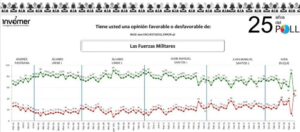
According to the survey, it can be evaluated that the Military Forces have enjoyed the trust of the people for whom they work, which is the basis of their most precious value, which is legitimacy; the security environment generated by the Military Forces assures development and economic progress, as a result of their effective and efficient work to maintain peace in the national territory. In the same sense, García (2003), referring to the text on the modern military, pointed out: “All these changes will delineate in the medium term a more technified and practical military professional without so many formal ties at the time of exercising his profession. In addition, he will be trained for a flexible, dynamic and fast command”. On the other hand, the official entity in Colombia responsible for the planning, survey, processing, analysis and dissemination of statistics is the National Administrative Department of Statistics (DANE), which in its report of May 2020 regarding the results of the survey on the culture of policy in terms of trust of all institutions in Colombia, shows that the Armed Forces is the entity in which Colombians trust the most at a general level, as can be seen in Graph 2.
Graph 2 Results of the Survey elaborated by DANE on Policy Culture in Terms of Trust – May 2020
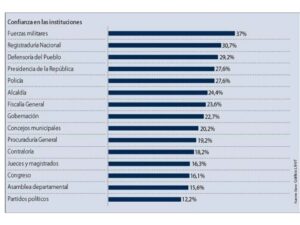
The traditional training of the National Navy that the crew members have been receiving in the Training Schools, must be enriched with the preparation and training for the special positions that allow them to assume the new external functions that the geopolitical reality and globalization impose; and that, in the Colombian case, must not only be carried out in the terms and the period that the internal conflict lasts, but may increase in the so-called post-conflict period, since as Diamint (2007) states:
…Officers must not only know how to wage war. They must also know how to install peace: restore or establish the rule of law, make institutions work, accompany economic reconstruction. Deepening the training of the uniformed for the tasks of Civil-Military Cooperation does not imply disregarding the traditional training of the men-at-arms.
The Colombian Navy has the challenge and commitment to adapt its security and defense institutions to the demands of the country’s reality. In which the type of education would be characterized by being critical, casuistic, deliberative, dynamic, flexible and open, allowing it to learn and apply its learning in an interdependent and constantly changing world, in order to achieve a regional influence according to the geopolitical and strategic educational factors to be a Navy of regional projection and influence.
In the National Navy of Colombia, the Training Schools are the units in charge of training the crew members in subjects related to the ships and units where they will exercise their profession. The educational act and the pedagogical approach of the programs of the Training Schools are centered on learning, in accordance with the guidelines established in the pedagogical model of the Navy of the Republic of Colombia for the Training Schools. Consequently, the teachers of the programs base their training activity on the application of the traditional method, where the role of the teacher and repetition emphasize training through will, discipline rigor and imitation of the ideal proposed as a pattern; in which the students are receivers of contents and the evaluation is a reproducer of knowledge at the end of the unit that seeks to verify the reception of the information given.
Geopolitical factors and educational stratics to be a Navy of regional projection and influence.
The determination of the geopolitical and strategic factors to be a Navy of regional projection and influence started from the identification of a definition of Medium Navy of Regional Projection for it was taken into account what was raised by Alonso and Gomez (2014), it is the adequate control of maritime, fluvial and terrestrial spaces, through its capabilities, to fulfill its multiple roles; as the result of a fair balance between the size of the force and its capacity to deploy it in these spaces, so that we are at the level of countries in our regional environment, even more so if we consider our condition as a bioceanic country.
Chart 3 Comparative Positioning of the National Navy
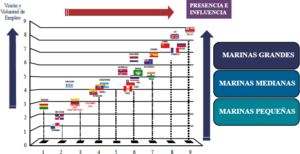
Taking as a starting point Graph 4. referring to the comparative positioning of the Colombian National Navy in 2014, which corresponds to a small navy with low presence and regional influence but with a force level of intermediate defense capability according to the model of characterization of navies in the world made by Professor Eric Grove (PhD) (1990), and taking into account the vision of the National Navy to 2042 in which it is desired to establish the future capabilities and means according to Graph 5 in a Navy of Medium Regional Force Projection with a range up to 200 nautical miles that will allow it to have a regional presence and influence.
Chart 4 Colombian Navy Vision to 2042

We proceed to establish the main geopolitical and strategic factors according to Table 1, which are not presented in order of importance or in hierarchical order, taking into account that they all complement each other and seek synergy in achieving the strategic objective, as follows:
Table 1. Comparison of Geopolitical and Strategic Factors in the Medium Navies of Regional Projection
- International cooperation, positive influence for the region and assistance response to catastrophic events.
Contextualizing the topic; and in order to approach it from different points of view; it is very important to remember that the cooperation between the actors of the international system raises different perspectives, which are based under a very volatile, uncertain, complex and often ambiguous environment.
It is also very important to point out that there are no theories of international cooperation to explain theories of international relations; on the contrary, there are theories of international relations to distinguish, observe and warn about cooperation among the actors of the international system. Therefore, in the present analysis, I will propose 02 theories of international relations to establish different positions regarding the possibilities of cooperation as a Medium Navy of Regional Projection.
In the first place, within the arguments that currently prevail worldwide with the regional influence are the postulates of the father of the Realist School of International Relations, Hans Morguentau (1904-1980), according to Barbe (1987), international cooperation is a means for the offerer to hold power and influence and establish a sphere of control in those states or areas of interest, international cooperation is a means of influence and power away from solidarity interests, seeking a vertical cooperation and achieving the respective ideological, political and / or economic support.
On the other hand, among the arguments that prevail in Colombia regarding international cooperation are Colombia’s historical policies regarding international cooperation, such as the conviction in multilateralism and strict adherence to international law, for the construction of an equitable and rule-based international order, in addition to the importance for Colombia of the UN and the OAS in Colombian foreign policy to influence global and regional decisions, For this I take the postulates of Ernst Hass in the Constructivism of International Relations, where he states according to Oyarzún (2008) that cooperation is based on solidarity aspects, if there are moral and solidarity reasons in international cooperation on the part of the actors of the international system, without power and influence from one to another being the main reason.
- Globalization: To make the country visible and present in the maritime order.
The National Navy must face the changes implied by an increasingly globalized world and with diverse demands for conflict resolution, and therefore it must be prepared to respond to them. Likewise, it must provide its crew members with the tools that allow them to prepare themselves, in order to maintain international standards in different areas, which are efficient, effective and efficient in the service of the Navy and its country.
The Colombian Navy has a more open and international outlook and shares similarities in terms of uniforms, symbols and ancestral traditions, which go beyond its own national traditions. According to Nye (2004), a state can obtain the influence it desires because other states decide to follow in its wake by admiring its values, emulating its example, and emulating its example.
his values, emulating his example or aspiring to his level of prosperity and openness in this interconnected world in the real and virtual, likewise he distinguishes two powers (soft and hard), but insists that in the context of globalization and knowledge, soft power becomes more important understanding this soft power as “The indirect way to get what you want has sometimes been called: the second face of power” (p.5), the importance of soft power for other States to realize what my national interests are projected in another State.
The intervention of the Colombian Navy in the Haitian earthquakes, with the arrival of the first ship in logistical support to such a regrettable catastrophe, is a reference example of the excellent administration and strategic planning of the National Navy, which must be continuously prepared to assume the demands made by the nations that require its help or cooperation, in addition to its influence in the participation of international operations such as UNITAS, Panamax, Bracolper, Deus Tricoleurs, DESI, RIMPAC, Jamaica Exchenge, ORION and the scientific expeditions to Antarctica.
- Geographical Condition
In this aspect, Colombia has a great potential for its geopolitical positioning in the maritime sphere, thanks to factors such as its geographical location, its physical configuration and the existence of large natural resources. In the first place, its geographic location gives it the condition of a bioceanic country, in addition to being the connection point with Central America and its proximity to the Panama Canal gives it access to the most important world maritime lines of communication that transit through the Isthmus, generating a favorable level of maritime connectivity. Secondly, its physical configuration has forced it to develop its foreign trade by sea, becoming the 4th country in Latin America and the Caribbean in terms of TEU mobilized in 2020 (ECLAC, 2020).
And finally, the existence of a wide biodiversity positions it as one of the few countries that have more than 40 marine species such as whales, sperm whales, beaked whales, marine dolphins, 6 of the 7 species of turtles that exist in the world and a number of coral reefs which are found in the biosphere reserve
Seaflower Biosphere Reserve. In addition to having an extensive mangrove ecosystem for being in the tropics being habitat of fish and crustaceans, bird nesting area and refuge for reptiles and amphibians. Likewise, it has the capacity to capture five times more carbon than other tropical forests, which makes it important for the control of greenhouse gases, in addition to serving as a filter for sediments, contributing to improve water quality; but in the face of future threats, the most important relationship between mangroves and humans lies in their capacity to protect the coast from erosion and natural disasters (National Geographic, 2020).
- Develop and protect maritime interests from mangrove control.
Referring to the protection of the set of goods and attributes of the sea, of the political, economic, social and military order, which a State considers useful and convenient to take advantage of and protect. It is materialized in the protection of maritime interests that occur on the surface of the sea, through transportation, maritime commerce, maritime tourism, sports and recreation; in the interior of the sea through fishing, aquaculture and energy; on the seabed, through submarine mining, geological resources; in the marine subsoil, through energy resources; on the coast, through the shipbuilding industry and ports.
This protection of maritime interests must be accompanied by a development in the international context, for which it is important to take as a precedent what Nye (2002) ratified, “Symply put, power is the ability to effect the outcomes you want, and if necessary, to change the behavior of others to make this happen” (p.4), which can be evidenced in the ability of a State to influence another State, which is determined by making the developments of the maritime interests in execution of a State in the other State.
- Maritime Governance
The Colombian State should raise among the strategies of the National Development Plans, the decentralization towards the regions as an alternative to reach a Unitary, equitable and Fair State, in which the most backward regions have the capacity to develop public policies in accordance with their maritime realities, the current challenges and the strategic use of their geographic position, to achieve a country that is positioned in the region as a determining actor.
In order to understand the impact of the National Development Plans, it is relevant to understand that Colombia is a centralized country, so that the resources and policies defined from the central or national level are in charge of facilitating the budget and delimiting the maritime strategies that need to be carried out in the territories in order to fulfill the purposes outlined in the maritime regions. In other words, regional actions are subject to the decisions of the central level.
- Innovation to achieve technological self-sufficiency and dual employment of
To achieve naval technological development in synergy with maritime development and dual employment of means, providing the conditions for the development of the naval shipyard industry, creation of quality employment, development of industries associated to the sector and export of high technology products to navies of other countries, but fundamentally to be at the forefront of technological developments that allow the National Navy to be in the world scenarios where strategic navies are present.
The above, recognizing the importance of innovation and creation to reach our own ideas of production, technology, and industry, in order to create our own naval technological development and have the opportunity to intervene more adequately in the geopolitics of the region.
Conclusions
To review, adjust, validate and disseminate the geopolitical and strategic factors proposed to be a Navy of projection and regional influence, in order to show evidence of continuous improvement in the organizational structure of the Training Schools, as well as to strengthen the New Education Model of the National Navy – MEDAR 18, with the assimilation of the leading role of the Training Schools regarding the generation of doctrine that can be exported and used as a means of influence in the region, on the other hand, it is necessary to define and propose new parameters of evaluation, measurement and comparison not only at national but also at international level, with peer military training schools in the national, regional and global context, in order to define a new naval leadership towards the consolidation of a regional middle power with naval education as a means.
Contribute to the Education System of the Colombian Armed Forces through the presentation of the geopolitical and strategic factors validated to be a Navy of regional projection and influence before the War College and the Heads in charge of education in the National Army and the Colombian Air Force, in order to identify common factors that can reach consensus in the projection of the interests of the Armed Forces to be influential in the educational issue at the regional level, in addition to making visible before the Ministry of National Education the importance of maritime education as a strategic element of the nation.
Bibliographical references
Alonso and Gómez (2014) Maritime power as a strategic foundation for the development of the nation. Bogotá, Colombia.
National Navy (2012). Strategic Plan for Naval Education 2012-2030 National Navy of Colombia (2006). Evaluation by competencies.
National Navy of Colombia (2016). Strategic Plan for Naval Education. National Navy of Colombia (2018). Naval Education Model MEDAR-18.
Navy of the Republic of Colombia (2020). Force Planning 2042. Bogotá: Armada Nacional.
Barbe, E. (2007). Relaciones Internacionales, 3 edition, Madrid.
Barbe E. (1987). The Role of Realism in International Relations Revista de Estudios Políticos. No. 57
Brito, J. P. (May-Jun 2000). La Estrategia Marítima, Orientadora del permanente accionar de la Armada, durante la guerra y la paz. Revista de Marina, 117(856), 203.
Clausewitz, Karl Von (1832) De la Guerra. Mexico: Diogenes Tomo I.
National Ocean Commission. (2018). National Policy of the Ocean and Coastal Spaces National Department of Planning (2020). CONPES 3990 – Colombia Potencia
Bioceánica Sostenible 2030. 91.
Cope, J. (1988). The institution and profession of Arms. CHDS: Lesson 3-01/02 Diamint, R. (2007) La Educación Democrática para Defensa. RESDAL Analysis Paper, Comparative Atlas.
RESDAL, Atlas Comparativo de la Defensa en América Latina. Buenos Aires.
GALLUP. (2020) Retrieved from https://www.asuntoslegales.com.co/actualidad/gallup133.pdf Grove, E. (1990) The Future of Sea Power. Routledge. London.
Hill, R. (1986). Maritime Strategy for Medium Power.
Holsti K. (1984). La crise des relations internationales: verbs un bilam, p. 751 Huntington, Samuel. (1995) The Soldier and the State. Buenos Aires: Grupo Editor Latinoamericano.
Ministry of National Defense (2008). Plan Estratégico del Sistema Educativo de las Fuerzas Armadas (Strategic Plan of the Armed Forces Educational System).
Ministry of Defense. (2016). Strategic Plan of the Defense and Security Sector. Bogotá: Ministry of Defense.
Ministry of National Defense (2019). Defense and Security Policies. Retrieved from https://www.mindefensa.gov.co/irj/go/km/docs/Mindefensa/Documentos/descargas/Pr ensa/Documentos/politica_defensa_deguridad2019.pdf.
National Geographic. National Geofraphic en español. Retrieved from https://www.ngenespanol.com/naturaleza/5-datos-importancia-manglares/
Nye Joseph S. (2002). The paradox of American Power: Why the World’s Only Superpower can’t go it Alone, New York, USA: Oxford University Press.
Nye Joseph S. (2004). Soft Power: The means to success in World Politics, New York, USA: Public Affairs.
Rengifo, A. J. (2008). Colombia en sus mares (A. d. Colombia, Ed.) Bogotá, Cundinamarca, Colombia.
Till, G. (2007). New Directions in Maritime Strategy? Implications for the U.S. Navy. Naval War College Review, 60(4), 29.
Tobon, J. (2006). Basic aspects of competency-based training.
Disclaimer: The views and opinions expressed in this article are those of the author. They do not necessarily reflect the official policy or position of any agency of the U.S. government, Diálogo magazine, or its members. This Academia article was machine-translated.

